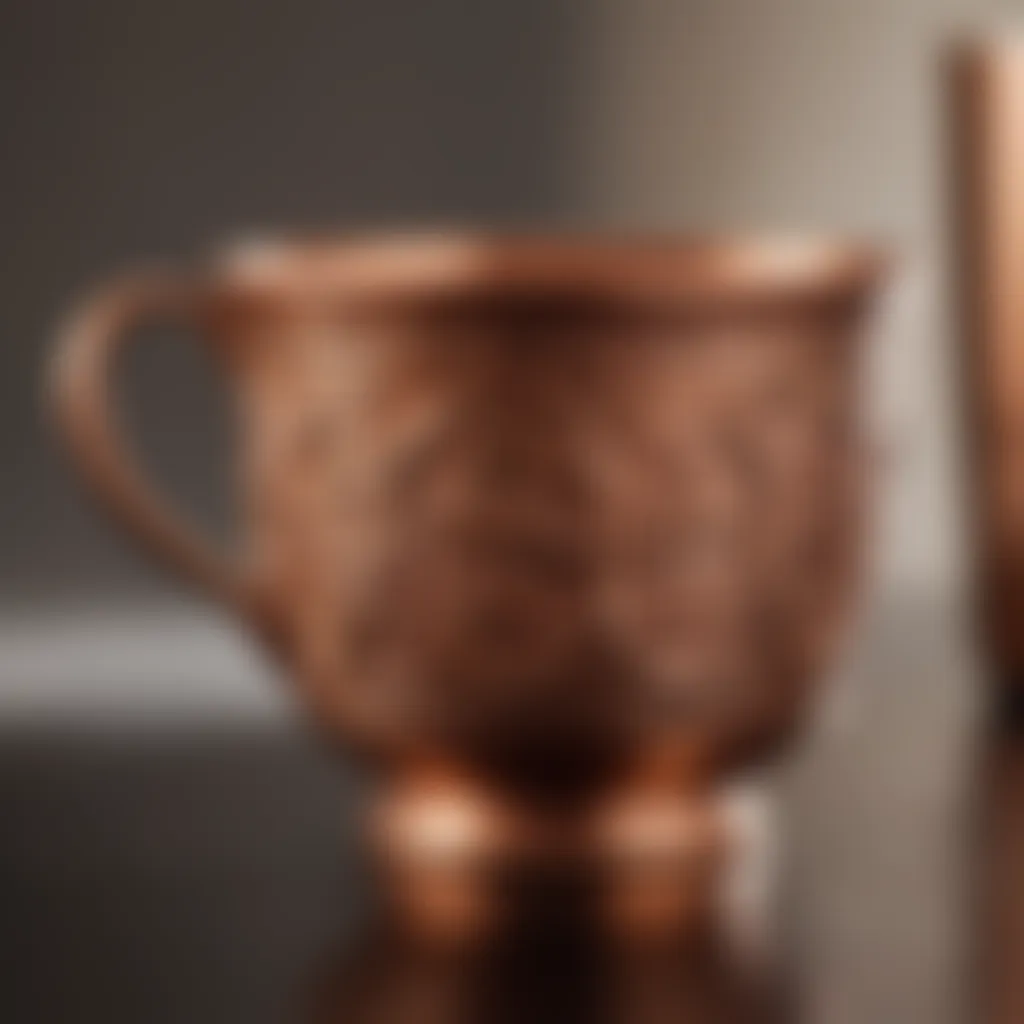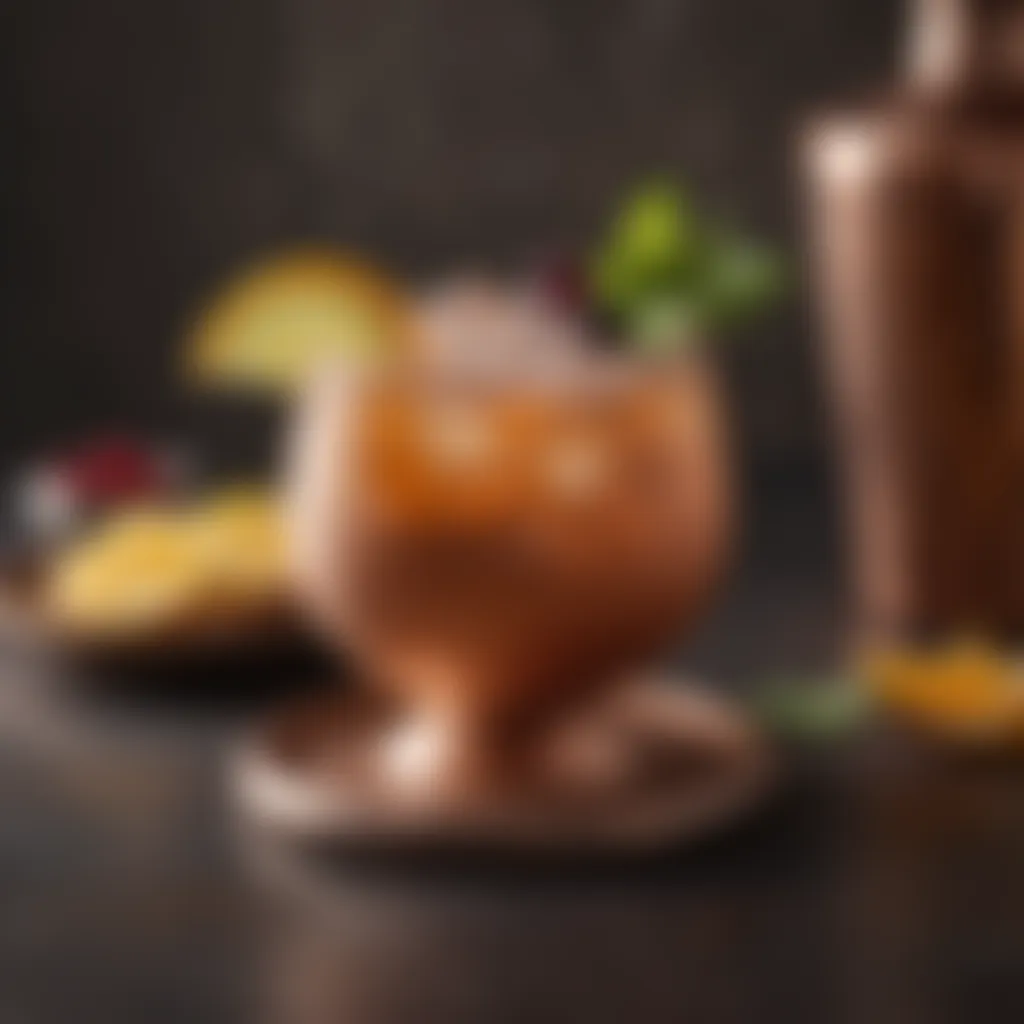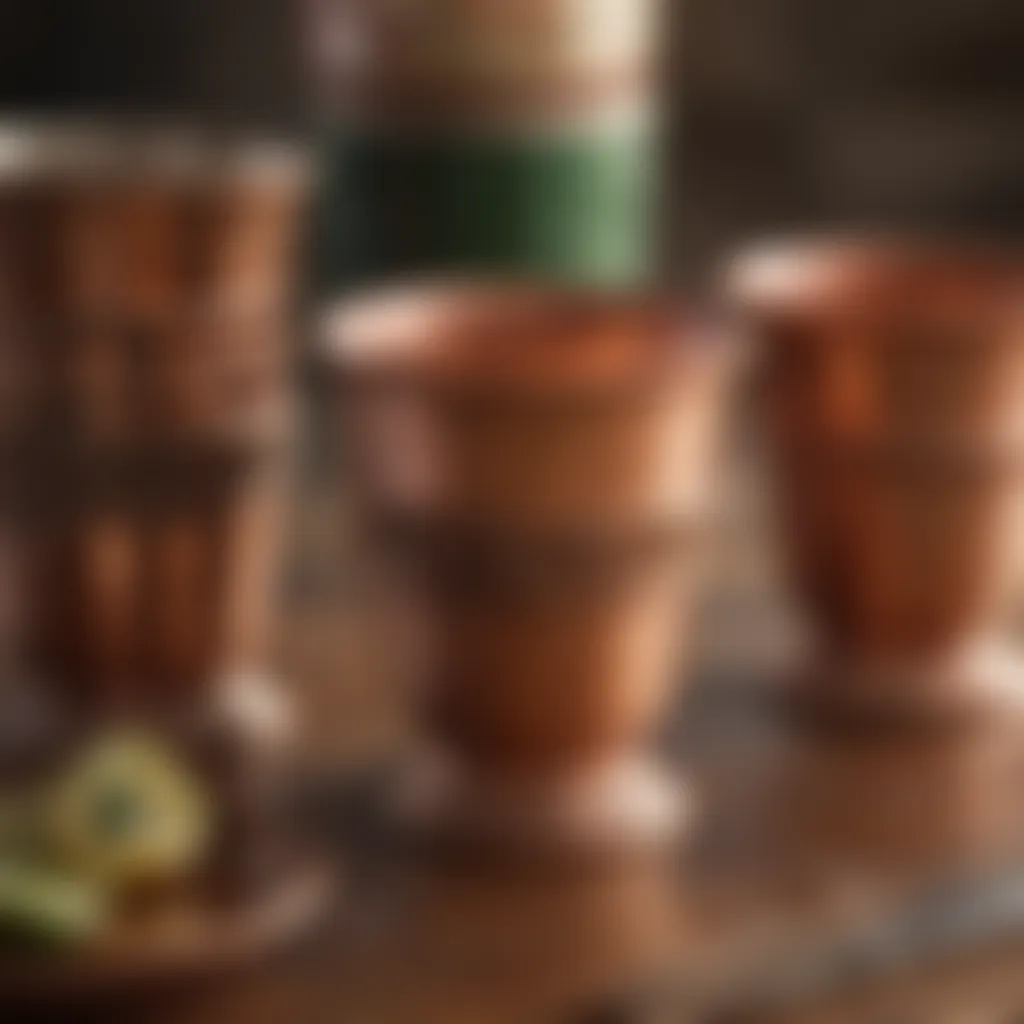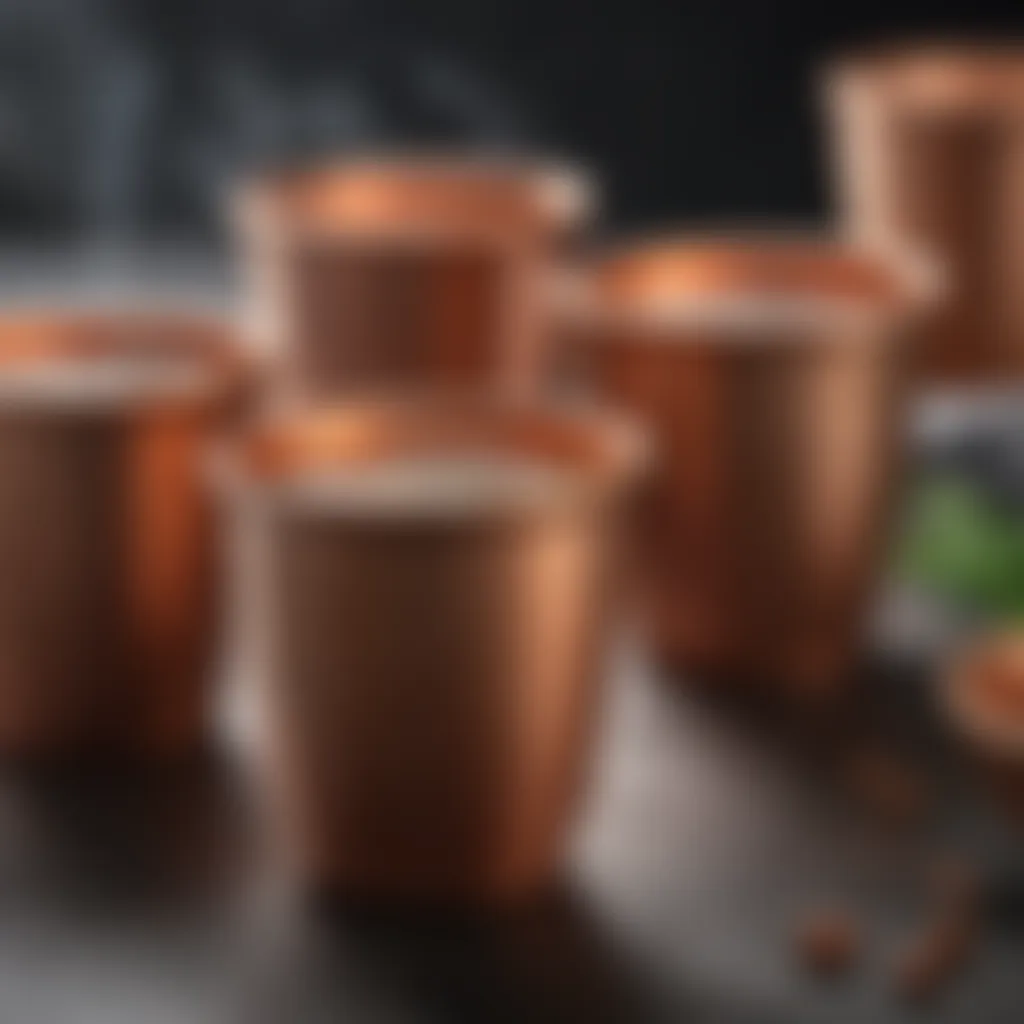The Allure and History of Copper Cup Cocktails


Intro
Copper cups have a rich history that intertwines culture and health. Distinctively known for their unique taste-enhancing properties, these vessels have been a beloved choice for many cocktail enthusiasts. Understanding their significance involves exploring their origins, health benefits, and the fine art of cocktail preparation. This article will guide you through the essentials of enjoying drinks served in these distinctive cups, helping you craft delightful beverages with a touch of elegance.
Ingredients:
To create a refreshing cocktail served in a copper cup, it's essential to gather the following ingredients:
- 2 oz Vodka
- 1 oz Fresh Lime Juice
- 4 oz Ginger Beer
- Ice (as needed)
- Lime Wedge (for garnish)
- Mint Leaves (for garnish, optional)
Detailed Instructions:
- Prepare the Copper Cup: Chill your copper cup by filling it with ice water. Let it sit while you gather other ingredients.
- Mix the Ingredients: In a shaker, combine the vodka and fresh lime juice. Add ice to fill the shaker halfway. Secure the lid and shake vigorously for about 15 seconds.
- Strain the Mixture: Empty the chilled cup of ice water and strain the vodka-lime mixture into the copper cup filled with fresh ice.
- Add Ginger Beer: Slowly pour the ginger beer over the vodka-lime mixture, allowing it to blend gently.
- Garnish the Drink: Add a lime wedge on the rim of the cup. If desired, include a few mint leaves for added fragrance.
Technical Aspects:
- Temperature Settings: Ensure that your vodka is chilled before mixing. The ideal serving temperature for cocktails is between 32°F and 38°F.
- Timing Specifics: Shaking should last roughly 15 seconds until the outside of the shaker becomes cold. This ensures proper mixing without dilution.
- Critical Techniques: When adding the ginger beer, pour gently to preserve the carbonation.
Cooking Process:
- Start with a Chilled Cup: Always serve the drink in a well-chilled copper cup to enhance the refreshment.
- Volume and Proportions: Ensure precise measurements for a balanced taste. Too much lime juice can overpower the drink, while too little vodka may weaken its punch.
- Ice Quality: Use fresh ice cubes rather than crushed ice to maintain the drink's chill without excessive dilution.
- Final Touches: After garnishing, serve immediately to ensure the optimal taste and experience.
Troubleshooting Tips:
- Drink Too Strong?: Add more ginger beer to balance the flavor.
- Too Diluted?: Reduce the amount of ice used during preparation.
- Lime Flavor Insufficient?: Adjust the lime juice proportion according to taste preference.
The allure of the copper cup is not merely aesthetic; the material itself has properties believed to enhance the drink's flavor profile, making it a favored choice among connoisseurs.
Prelude to Copper Cup Drinks
Copper cup drinks hold a distinct place in the world of beverages and cocktails. Their significance goes beyond aesthetics, influencing flavor, temperature, and even the health aspects of the drinks they hold. This section serves as a gateway into the multifaceted world of copper cups, examining the reasons they have become prevalent in cocktails.
The use of copper containers dates back centuries, tracing its roots through various cultures. This historical context not only serves to enrich our understanding but also highlights the craft that has evolved over time.
Moreover, copper cups are more than just decorative items. They possess unique properties that enhance the drinking experience. The thermal conductivity of copper keeps beverages cold, providing a refreshing sip on warm days. This makes them particularly appealing for summer cocktails, such as the well-known Moscow Mule.
Additionally, there are numerous benefits associated with drinking from copper vessels. The antimicrobial properties of copper can contribute to overall health, an aspect we will explore further in subsequent sections. Overall, copper cup drinks represent a blend of tradition, functionality, and wellness, making their study worthwhile.
Historical Background
The history of copper cup drinks is rich and varied. Originating from ancient civilizations, copper was valued not only for its beauty but also for its practical properties. Historical artifacts suggest that ancient Egyptians and Greeks utilized copper vessels in their daily lives. These cultures recognized the benefits of copper for storing and drinking liquids.
In the 19th century, the use of copper cups in mixology gained popularity. The establishment of the Moscow Mule in the 1940s, which was served in a copper mug, marked a significant moment in cocktail culture. The drink was crafted with vodka, ginger beer, and lime, all served in a chilled copper cup, forever altering the beverage landscape.
As cocktails regained popularity in the early 21st century, copper vessels made a remarkable comeback. Bartenders and enthusiasts embraced their aesthetic appeal and practical benefits, leading to a resurgence of classic cocktails served in copper.
Cultural Significance
Copper cups have woven themselves into various cultural narratives. They are not merely vessels but symbols of craftsmanship and tradition. In some cultures, they are associated with special occasions and often used in celebratory events.


In many places, the act of drinking from a copper cup is akin to a ritual. It denotes a connection to history and a respect for the drink itself. Different cocktails served in copper mugs often come with a story, enriching the drinking experience.
"Copper mugs have become a symbol of classic cocktails, embodying a blend of tradition and modern craftsmanship."
Furthermore, the global influence of the Moscow Mule has introduced copper cups to many cultures beyond their origins. This cultural penetration has sparked curiosity and exploration, encouraging individuals to experiment with various drinks served in these iconic vessels.
In essence, the cultural significance of copper cups transcends their utility, making them an integral part of celebrations and gatherings, a testament to their enduring appeal.
Materials Used in Copper Cups
The materials chosen for crafting copper cups hold significance beyond mere aesthetics. They influence not just the visual appeal, but also the functional characteristics of the cups. Understanding these materials helps in making informed choices when selecting copper vessels for enjoyment of beverages. This section delves into the types of copper used and the coatings or linings that may accompany them.
Types of Copper and Their Properties
Copper cups are often created from different types of copper, each equipped with unique properties. The most common types include:
- Electrolytic Tough Pitch (ETP) Copper: This is the standard choice for most copper cup manufacturing. ETP copper has high electrical conductivity and thermal properties, ideal for maintaining drink temperature.
- Pure Copper: Sometimes used in high-end products, pure copper is renowned for its excellent conductivity. However, it can tarnish quickly, requiring regular maintenance.
- Copper Alloys: Some cups are made from copper alloys combining copper with other metals. These alloys can provide increased strength and durability, but may alter the flavor of the drink.
The thickness of the copper also matters. Thicker copper promotes better insulation and reflects heat well. Lighter copper can lose its temperature quickly and may not provide the same aesthetic appeal.
Coatings and Linings
Coatings and linings are crucial aspects in the construction of copper cups.
- Nickel Lining: A common option, nickel linings provide a barrier between the copper and the beverage. This prevents any metallic taste from leaching into the drink and adds a level of durability to the cup.
- Food-Grade Lacquer: Some cups are treated with a food-grade lacquer to protect the copper from tarnishing. This lacquer does not affect the sip experience and can help maintain the cup's aesthetic.
- No lining: Traditional copper cups, particularly those crafted for the Moscow Mule, often have no lining. This approach embraces the natural properties of copper, allowing it to impart some of its health benefits but necessitating more care.
"The choice of lining or coating should align with the intended use of the cup and personal preferences regarding flavor and maintenance."
In summary, the materials used in crafting copper cups affect both their durability and the quality of the drinks served. Understanding these details can enhance your drinking experience, allowing you to enjoy both the aesthetics and the unique qualities that copper brings to your favorite beverages.
Crafting the Perfect Drink
The process of crafting the perfect drink transcends mere mixing of ingredients; it encapsulates a blend of art, science, and tradition. This article segment zeroes in on the nuances that make drinks served in copper cups exceptionally delightful. From understanding the differences in glassware to selecting the right ingredients, every detail contributes profoundly to the overall experience. It is paramount to grasp these elements, as they have real implications for flavor profiles, presentation, and even health benefits.
Glassware Versus Copper Cups
When considering the ideal vessel for your cocktails, the choice between glassware and copper cups becomes crucial. Glassware has long been the standard for many cocktails. It allows for an unimpeded view of the drink, enhancing its visual appeal. Yet, copper cups offer something that glass cannot replicate. The thermal conductivity of copper serves to chill the drink more efficiently. This chilled effect not only impacts the temperature but also influences the taste.
Copper also has an excellent effect on carbonated drinks, such as the Moscow Mule, where it helps retain effervescence longer than glass. The tactile nature of copper adds character, inviting the drinker to savor the moment more mindfully. However, one must also consider care and maintenance, as copper cups require more effort to keep in prime condition.
"Choosing the right cup is not just about aesthetics; it affects the experience of drinking."
Essential Ingredients
Crafting an exceptional cocktail involves careful selection of ingredients. Freshness is key. Quality ingredients add depth and character, transforming a simple drink into a spectacular experience. For cocktails typically served in copper cups, consider using organic ingredients. These often have a more robust flavor profile.
Here are some essential components for a well-rounded cocktail:
- Base spirit: Vodka or bourbon often serve as the backbone, providing the primary flavor.
- Citrus: Fresh lime juice is commonly used. It brings acidity that balances sweetness.
- Mixer: High-quality ginger beer is a staple for many copper cup cocktails. It adds spice and complexity.
- Garnish: Fresh herbs or citrus peels enhance aromas and burst of flavor when consumed.
Each of these components plays a pivotal role in achieving balance, ensuring that the drink is both refreshing and enjoyable. Therefore, taking the time to select and prepare these elements carefully will yield significantly better results than simply following a recipe without consideration.


In summary, crafting the perfect drink extends beyond just mixing ingredients. It includes an understanding of how materials influence preparation and enjoyment. Choosing copper cups over traditional glassware can elevate the experience while paying close attention to ingredient quality guarantees a drink that resonates well with your palate. This intricate dance between vessel and ingredient serves as a foundation for enjoying a truly delightful cocktail.
Health Aspects of Copper Drinking Vessels
The inclusion of copper drinking vessels in modern culture warrants an examination of their health aspects. Health is a vital consideration when enjoying any beverage. Copper, as a material, has garnered attention not only for its aesthetic qualities but also for its potential health benefits. This section delves into the antimicrobial properties of copper and its broader health implications. Providing the reader with insightful information on these topics creates a better understanding of why copper cups have made a lasting impression in both historical and contemporary drinking practices.
Antimicrobial Properties
Copper is known for its antimicrobial properties, which can play a significant role in the safety of drinking vessels. Research indicates that copper surfaces can kill harmful bacteria and viruses. This feature is particularly beneficial in preventing the transmission of pathogens. The effective elimination of microbes on copper surfaces provides an important layer of protection, especially in social settings where drinks are shared. Not only does it enhance the overall drinking experience, but it also assures users that their choice of drinkware contributes to their health.
"Copper's inherent ability to reduce microbial contamination enhances the safety of using copper drinking vessels."
Potential Health Benefits
When considering the health aspect of drinking from copper vessels, two significant benefits arise: micro-nutrient absorption and antioxidant effects. Understanding these features elucidates the reasons behind the growing popularity of copper cups in the beverage industry.
Micro-nutrient Absorption
One significant advantage of using copper vessels is their potential to enhance micro-nutrient absorption in the body. Copper is an essential trace mineral that plays a vital role in various bodily functions, including the formation of red blood cells and the absorption of iron. Drinking liquids stored in copper containers can promote this absorption by facilitating the transfer of copper ions into the liquid. This characteristic makes copper cups a beneficial choice for individuals seeking a natural way to improve their mineral intake. Furthermore, incorporating copper in daily hydration practices could support overall health through increased levels of copper, which can contribute to better immunity and cardiovascular health.
Antioxidant Effects
Another important aspect of drinking from copper vessels is their possible antioxidant effects. Copper can assist in the scavenging of free radicals in the body, helping to combat oxidative stress. This property is crucial for maintaining cellular health and preventing various chronic diseases. Regular consumption of beverages from copper cups may aid in enhancing overall wellness by providing an extra source of antioxidants naturally. However, moderation is essential, as excessive copper consumption can lead to toxicity. Therefore, understanding these effects contributes to more informed choices about beverage storage and consumption.
In summation, the health aspects of copper drinking vessels present a compelling case for their use. The antimicrobial properties, combined with potential benefits like enhanced micro-nutrient absorption and antioxidant effects, mark these vessels as valuable additions to the modern drinking experience.
Popular Cocktails in Copper Cups
The use of copper cups in cocktail culture is more than just a visual preference; it serves a distinct purpose. The choice of vessel can influence not only presentation but also the sensory experience of the drink. Copper offers a unique aesthetic appeal and functional benefits, enhancing both flavor and temperature retention.
The concept of popular cocktails in copper cups primarily revolves around drinks that not only taste divine but also showcase the cup's capabilities. Notably, the Moscow Mule and Kentucky Mule are among the most celebrated recipes served in these distinctive vessels, each signifying a blend of tradition and creativity.
Moscow Mule
The Moscow Mule is perhaps the most iconic copper cup cocktail. This delightful mix of vodka, ginger beer, and lime juice is known for its refreshing taste and crisp finish. The drink's foundations trace back to the 1940s in the United States, where its rise coincided with the popularity of vodka. However, serving it in a copper cup adds a layer of allure.
Benefits of the Moscow Mule served in copper include:
- Temperature Maintenance: Copper's thermal conductivity maintains the cold temperature of the drink longer than standard glassware.
- Taste Profile Enhancement: The mug can subtly alter the taste profile, making the drink more enjoyable. The metallic hint can complement the spiciness of ginger beer.
- Visual Appeal: The gleaming copper surface is visually striking, making it a trendy choice for social settings.
While it may seem simple to prepare, the Moscow Mule requires careful attention to the balance of ingredients. Using high-quality vodka and fresh lime juice is essential for achieving the ideal flavor.
Kentucky Mule
The Kentucky Mule introduces a twist by substituting bourbon for vodka, resulting in a richer taste. This variation reflects the growing appreciation for bourbon in modern cocktail culture. The marriage of bourbon, ginger beer, and lime creates a robust drink that seduces the palate.
Considerations regarding the Kentucky Mule served in copper cups include:
- Flavor Complexity: The robust character of bourbon mixes harmoniously with the spiciness of ginger beer, offering deeper flavor notes.
- Cultural Reflection: This drink showcases the Southern roots of bourbon, resonating with the region’s rich drinking traditions.
- Social Experience: Sharing Kentucky Mules can foster a warm, convivial atmosphere, making it a perfect choice for gatherings.
In both cocktails, the copper cup enhances not only the enjoyment but also the presentation. Its cultural roots and ongoing popularity reflect the evolving nature of cocktail crafting in today's culinary landscape.


Trends in Copper Drinking
In recent years, the allure of copper drinking vessels has significantly impacted both cocktail culture and environmental awareness. The embrace of copper vessels, particularly cups, highlights essential elements that resonate with contemporary preferences. From aesthetics to health benefits, these trends reflect a nuanced understanding of not just what we drink, but how the experience shapes our enjoyment.
Craft Cocktail Movement
The craft cocktail movement plays a crucial role in elevating the significance of copper cups. Bartenders and mixologists continuously seek ways to create unique drinking experiences. Copper adds an element of sophistication and tradition to cocktails, making them appear more refined. The aesthetic appeal of a gleaming copper cup is undeniable.
When crafting cocktails, the choice of serving vessel can profoundly influence flavors and perceptions. For instance, serving a Moscow Mule in a copper cup enhances the drink’s coolness, while also adding a subtle touch of copper flavor, which some might find intriguing. This trend encourages creativity in cocktail-making and promotes a greater appreciation of artisanal methods.
In addition to aesthetics, the craft cocktail movement emphasizes the provenance of ingredients. Many mixologists are sourcing locally produced spirits or organic mixers. A copper cup complements this trend by embodying the artisanal nature of modern cocktail culture.
Sustainability Efforts
Sustainability is another trend intertwining itself with the emergence of copper drinking vessels. As concerns about the environment grow, consumers become more aware of the materials used in everyday items. Copper, being a natural metal, is one of the more sustainable choices compared to plastic. This is significant because it aligns with the increasing demand for eco-friendly products.
Using copper cups encourages a shift towards reusable drinking vessels. The durability of copper also means that these cups can last for many years, reducing waste associated with disposable drinkware. Additionally, many manufacturers are keen on implementing sustainable practices in their production process. This commitment to sustainability not only fosters responsible consumption but also heightens the overall appreciation for copper cups as long-lasting investments.
"Choosing copper cups is not just about enjoying a drink; it's about making an eco-conscious decision that impacts the planet positively."
Care and Maintenance of Copper Cups
Caring for copper cups is important not only for maintaining their aesthetic appeal but also for ensuring their longevity. Copper is a reactive metal that can tarnish or develop corrosion over time due to exposure to moisture and acids in foods and drinks. Proper maintenance helps retain their distinctive finish, functionality, and health benefits associated with drinking from these vessels.
Cleaning Techniques
The cleaning of copper cups should be done with care. Using abrasive materials can scratch the surface and diminish the natural luster. Instead, a simple approach works best:
- Soap and Water: Use mild dish soap mixed with warm water. Avoid harsh chemicals. A soft sponge or cloth is advisable to wipe down the interiors and exteriors of the cups.
- Vinegar and Salt: For more stubborn tarnish, mix vinegar and salt to form a paste. Apply gently with a cloth, then rinse well with warm water and dry immediately.
- Ketchup Method: Surprisingly, ketchup can also work well. The acidity in ketchup helps lift tarnish without abrasive scratching. Rub it on the cup, let it sit for a few minutes, and then rinse it off.
"Maintaining your copper cups enhances their beauty and extends their life. Regular cleaning and appropriate use are key."
Long-term Care Guidelines
To prolong the life of your copper cups and keep them looking pristine, follow these long-term care guidelines:
- Avoid Dishwasher: Do not place copper cups in the dishwasher. The heat and harsh detergents can discolor and degrade the coating over time.
- Store Properly: Store your copper cups in a dry place. Avoid stacking them together, as this can lead to scratches. Placing a soft cloth in between can help.
- Protective Coating: Some copper cups come with a protective coating that reduces tarnishing. If yours does, maintain that coating by following the manufacturer’s recommendations. If it wears off, consider reapplying a food-safe lacquer to preserve the look.
- Regular Inspection: Periodically check your cups for signs of tarnish or scratches. Addressing these issues promptly will prevent further damage and maintain their functionality.
By applying these cleaning techniques and long-term care guidelines, you can ensure that your copper cups remain a beautiful and functional part of your drinkware collection.
Finale
The conclusion of this article underscores the multifaceted significance of copper cup drinks. Emphasizing elements such as historical significance, health benefits, and the craftsmanship involved in preparing these unique beverages, it wraps up several key insights that readers can carry forward.
Firstly, the historical context is vital in understanding the appeal of copper cups. These vessels have been used for centuries, not just for their aesthetic qualities but also due to their functional benefits. Today, they serve as a bridge connecting modern cocktail culture to ancient traditions, offering a sense of nostalgia and authenticity.
Secondly, health considerations are paramount. The antimicrobial properties of copper have been studied and documented. Using copper cups might enhance the flavor and freshness of drinks, potentially leading to a more enjoyable experience. Furthermore, the potential health benefits, such as improved micro-nutrient absorption and antioxidant effects, highlight copper's remarkable properties.
As we analyze the trends in copper drinking, it’s clear that the craft cocktail movement has rejuvenated interest in these types of vessels among enthusiasts. Sustainable practices are becoming prominent, ensuring that the production and use of copper cups align with modern values of environmental consciousness.
Future of Copper Cup Drinks
Looking ahead, the future of copper cup drinks appears promising. As more people become aware of both the cultural roots and the health benefits of these cups, demand may steadily rise. Many bartenders are embracing this trend by incorporating copper mugs into their drink menus, adding a visually appealing element to the drink experience.
Additionally, with innovations in design and technology, manufacturers might introduce different styles and types of copper cups, enhancing functionality while ensuring sustainability. The focus on eco-friendly materials and practices could revolutionize the market.
Ultimately, as copper cup drinks become more integrated into social gatherings and bars, they may emerge not just as a trend but as a staple in the drinking culture. It remains to be seen how this will unfold, but the intertwining of tradition and modern techniques suggests that copper cups will continue to charm and captivate drinkers for years to come.







